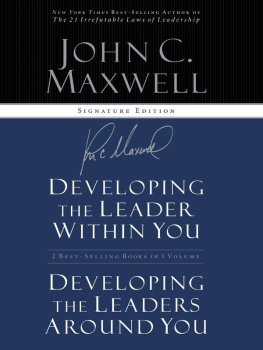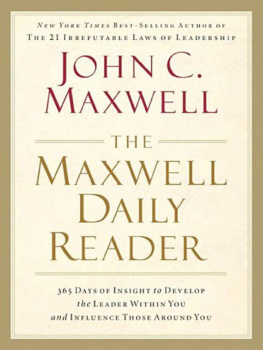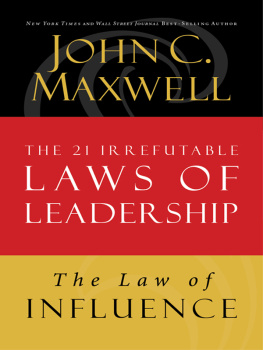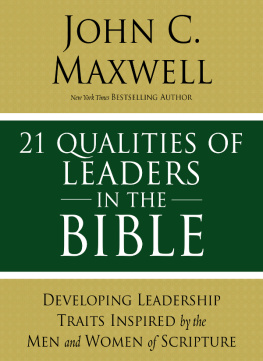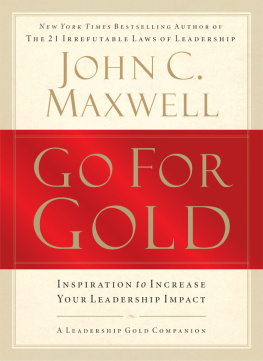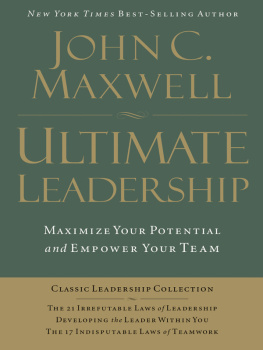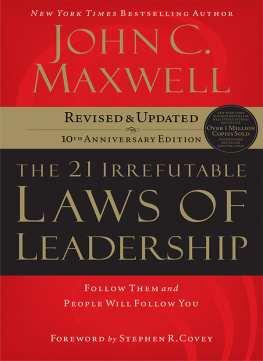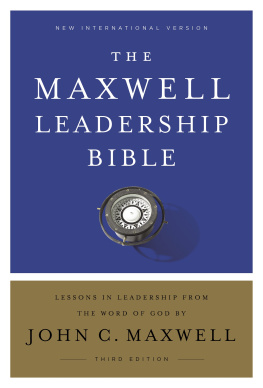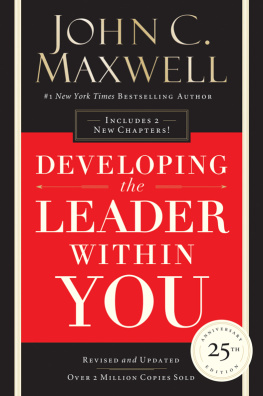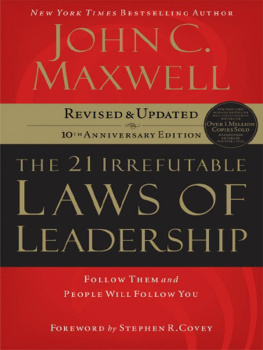LEADERSHIP
LEADERSHIP
WHAT EVERY LEADER NEEDS TO KNOW
JOHN C. MAXWELL

Copyright 2002 by Maxwell Motivation, Inc.,
a Georgia Corporation
All rights reserved. Written permission must be secured from
the publisher to use or reproduce any part of this book,
except for brief quotations in critical reviews or articles.
Published in Nashville, Tennessee, by Thomas Nelson. Thomas Nelson
is a registered trademark of Thomas Nelson, Inc.
Thomas Nelson, Inc., titles may be purchased in bulk for educational,
business, fund-raising, or sales promotional use. For information,
please e-mail SpecialMarkets@ThomasNelson.com.
Portions of this book were previously published in Becoming a Person of
Influence, The 21 Irrefutable Laws of Leadership, The 21 Indispensable
Qualities of a Leader, and Developing the Leader Within You.
Library of Congress Cataloging-in-Publication
Maxwell, John C., 1947
Leadership 101 / John C. Maxwell.
p. cm.
ISBN 13: 978-0-7852-6419-4
1. Leadership. I. Title: Leadership one hundred one. II. Title.
HM1261 .M3897 2002
303.3'4dc21
2002009572
Printed in the United States of America
10 11 12 13 WC 39 38 37 36
CONTENTS
W elcome to Leadership 101. You may be wondering why Im doing another book on leadership. Let me tell you a story that will explain how Leadership 101 came about and why were doing it.
Every year I am invited to speak to the employees of Thomas Nelson Publishers in Nashville, Tennessee, and I am delighted to do it. I consider my publishers to be partners with me, and for a decade Thomas Nelson has been a good partner.
During my most recent visit, I got to speak to all of the publishers employees, from presidents to warehouse workers, and I explained to them why I write books. I do it because I want to help people be successful. And I believe that to be a success in life, a person needs to be able to master skills in four areas: Relationships, Equipping, Attitude, and Leadership. Those are the four subjects I write books about, and thats why I say that anyone can be a REAL success.
After I was done speaking, Mike Hyatt, the publisher of Thomas Nelson, and Pete Nikolai, the vice president of backlist development, came up to me and said, John, people are always asking for small books that they can read in one sitting. You really ought to do a short easy-to-read book on each of those subjects. And you should start with the subject that put your books on The New York Times and BusinessWeek bestsellers listsleadership.
What they said is really true. Peoples lives are hectic, their time is valuable, and at the same time they are on information overload. Did you know that more new information has been produced in the last thirty years than in the previous 5,000? A weekday edition of The New York Times contains more information than average people in seventeenth century England were likely to come across in their lifetime. The amount of information available in the world has doubled in the last five years, and it keeps doubling.
Thats why weve introduced Leadership 101. Its the first in a series of four books that gives you the short course on what it takes to become a REAL success. In Leadership101, Ive collected what you need to know for the bottom line on leadership. This book contains the essentials gained from more than thirty years of leadership experience. It defines leadership, identifies a few traits every leader should develop, and shows the impact leadership can have on your life and the lives of those you lead.
Did you know that each of us influences at least ten thousand other people during our lifetime? So the question is not whether you will influence someone, but how you will use your influence. This book is designed to help you develop your leadership ability and increase your personal and organizational success. Whether your desire is to build a business, strengthen your children, or reach the world, the first step in achieving it is raising your level of leadership.
Sir Francis Bacon observed that knowledge is power. Back when he lived and information was scarce, that may have been true. But today, it would be better to say that knowledge empowersas long as its what you need. My desire is to empower you and to see you at the next level.
PART 1
THE DEVELOPMENT
OF A LEADER
I
WHY SHOULD I GROW AS A LEADER?
The higher the leadership,
the greater the effectiveness.
I often open my leadership conferences by explaining what I call the Law of the Lid because it helps people understand the value of leadership. If you can get a handle on this principle, you will see the incredible impact of leadership on every aspect of life. So here it is: Leadership ability is the lid that determines a persons level of effectiveness. The lower an individuals ability to lead, the lower the lid on his potential. The higher the leadership, the greater the effectiveness. To give you an example, if your leadership rates an 8, then your effectiveness can never be greater than a 7. If your leadership is only a 4, then your effectiveness will be no higher than a 3. Your leadership abilityfor better or for worsealways determines your effectiveness and the potential impact of your organization.
Let me tell you a story that illustrates the Law of the Lid. In 1930, two young brothers named Dick and Maurice moved from New Hampshire to California in search of the American Dream. They had just gotten out of high school, and they saw few opportunities back home. So they headed straight for Hollywood where they eventually found jobs on a movie studio set.
After a while, their entrepreneurial spirit and interest in the entertainment industry prompted them to open a theater in Glendale, a town about five miles northeast of Hollywood. But despite all their efforts, the brothers just couldnt make the business profitable, so they looked for a better business opportunity.
A NEW OPPORTUNITY
In 1937, the brothers opened a small drive-in restaurant in Pasadena, located just east of Glendale. As people in southern California became more dependent on their cars in the thirties, drive-in restaurants sprang up everywhere. Customers would drive into a parking lot around a small restaurant, place their orders with carhops, and receive their food on trays right in their cars. The food was served on china plates complete with glassware and metal utensils.
Dick and Maurices tiny drive-in restaurant was a great success, and in 1940, they moved the operation to San Bernardino, a working-class boomtown fifty miles east of Los Angeles. They built a larger facility and expanded their menu from hot dogs, fries, and shakes to include barbecued beef and pork sandwiches, hamburgers, and other items. Their business exploded. Annual sales reached $200,000, and the brothers found themselves splitting $50,000 in profits every yeara sum that put them in the towns financial elite.
By 1948, their intuition told them that times were changing, so they made modifications to their restaurant business. They eliminated the carhops and started serving only walk-up customers. They reduced their menu and focused on selling hamburgers. They eliminated plates, glassware, and metal utensils, switching to paper products instead. They reduced their costs and the prices they charged customers. They also created what they called the Speedy Service System. Their kitchen became like an assembly line, where each person focused on service with speed. Their goal was to fill each customers order in thirty seconds or less. And they succeeded. By the mid-1950s, annual revenue hit $350,000, and by then, Dick and Maurice split net profits of about $100,000 each year.
Next page
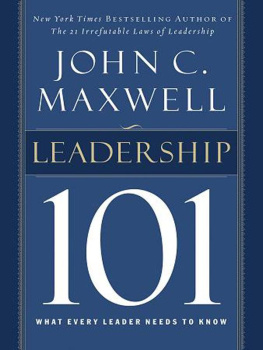

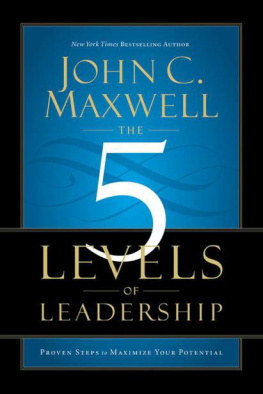

![Maxwell - The 360 [-degree] leader: developing your influence from anywhere in the organization](/uploads/posts/book/218782/thumbs/maxwell-the-360-degree-leader-developing-your.jpg)
